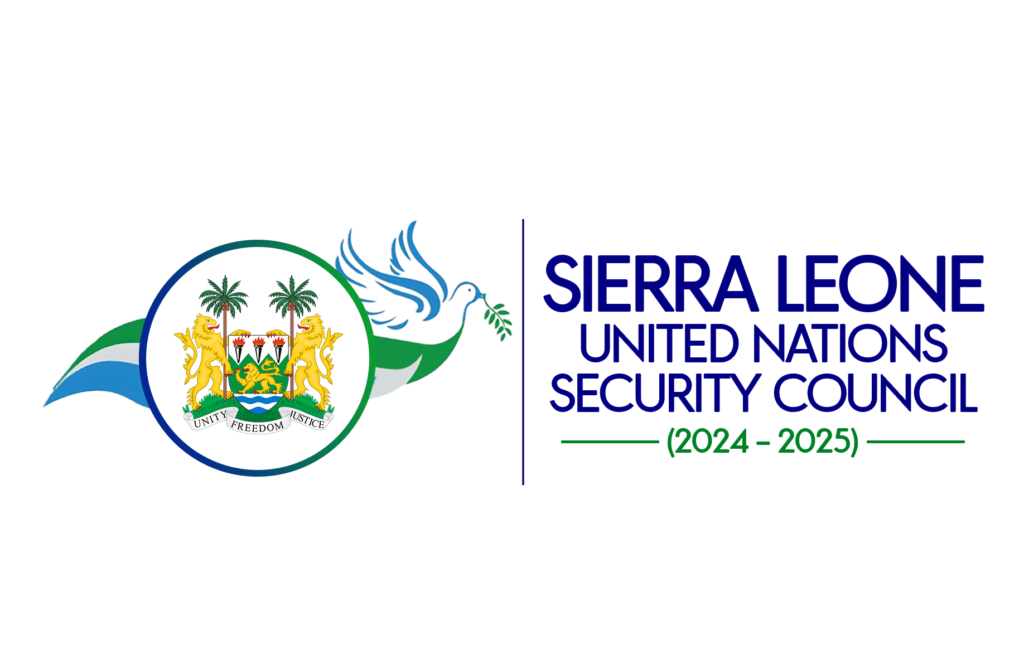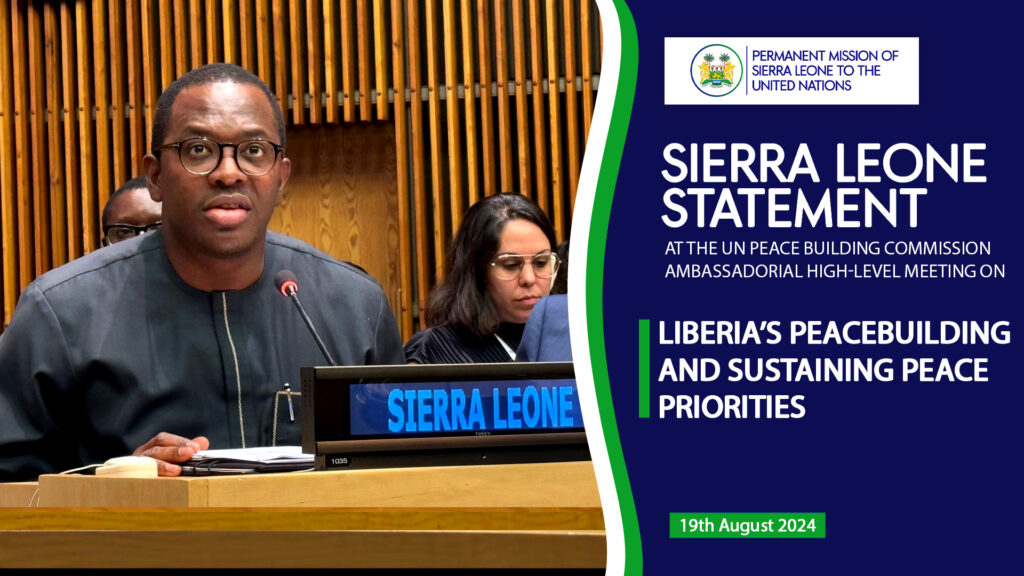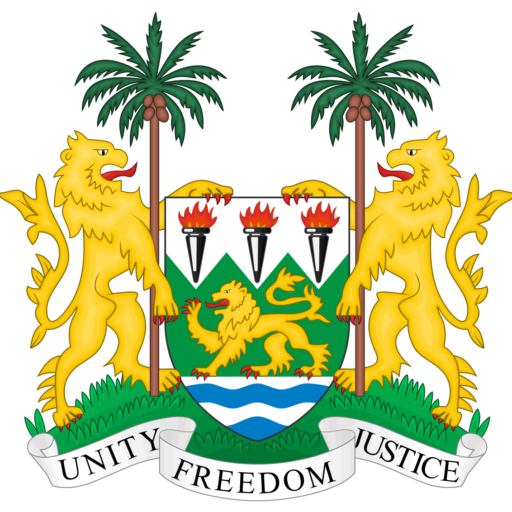BY
H.E. DR. MICHAEL IMRAN KANU
AMBASSADOR AND PERMANENT REPRESENTATIVE
Chair,
Excellencies,
I thank you Chair and the members of the Liberia Configuration of the Peacebuilding Commission (PBC) for inviting me to share experiences and lessons learnt on Sierra Leone’s peacebuilding journey.
Let me also thank the Peacebuilding Support Office for their unwavering and commendable efforts.
Sierra Leone is pleased to be here today to discuss Liberia’s peacebuilding and sustaining peace priorities, including support to the establishment of a War and Economic Crimes Court and the National Action Plan on Youth, Peace and Security.
Beyond borders, Sierra Leone shares a lot with Liberia, including common traditions, culture and people. Sustained peace in Liberia means sustaining peace in Sierra Leone and therefore of critical importance.
Excellencies, as you are aware, Sierra Leone has a special history with the PBC. When the Commission was established in 2005, Sierra Leone was one of the first countries on its agenda, and in December 2020, Sierra Leone exited the formal PBC agenda as a success story.
As a way to contribute to the discourse on strengthening peacebuilding in Liberia by briefly sharing Sierra Leone’s post-conflict path towards sustaining peace, with a particular focus on transitional justice, starting with the reasons why Sierra Leone needed a recourse to transitional justice.
In March of 1991, an armed group called the Revolutionary United Front marched from the southeastern border with Liberia into Sierra Leone, with the intent of taking over State power. While the root causes of the war have been attributed to many factors over the years, key grievances such as poverty and the marginalization of youth, lack of access to justice and other basic human rights, including education, have been cited as the main drivers of the conflict .
What followed was a devastating decade during which over 50,000 Sierra Leoneans are estimated to have lost their lives, thousands more suffered amputations, and millions became displaced or refugees. It was a very dark period in our history. In 2002, the war was officially declared over and in the same year, Sierra Leone’s Truth and Reconciliation Commission (TRC) started its work.
The TRC was mandated to “address impunity, break the cycle of violence, provide a forum for both the victims and perpetrators of human rights violations to tell their story […] in order to facilitate genuine healing and reconciliation”.
Based on traditional methods of healing, the TRC provided a space for public testimony and private healing. As part of the process, the public was often reminded by the then President Ahmed Tejan Kabbah and his government of the need to “forgive” for the sake of peace.
Combatants were encouraged to drop their weapons and return to “normal” life, whilst local populations were encouraged to welcome back their “children, brothers, sisters”.
Taking the above into account and in a bid to ensure that justice was also served, in January of 2002, the Special Court for Sierra Leone (SCSL) was also established. This marked the first time that a criminal tribunal would operate alongside a truth commission, albeit without the mandate of receiving information from the TRC and therefore ensuring that ex-combatants would testify before the TRC without fear of being prosecuted by the SCSL.
The Court itself was mandated to prosecute “those who bear the greatest responsibility” for crimes against humanity, war crimes, and violations of Sierra Leonean law committed in Sierra Leone since 30 November 1996 – the date of the Abidjan Peace Accord between the Government of Sierra Leone and the Revolutionary United Front – until the end of the conflict.
The SCSL was established as a result of a request made to the United Nations by the then President Kabbah. Following his request, the Security Council by resolution 1315 (2000) mandated the Secretary-General to begin discussions with the Government of Sierra Leone with a view towards establishing the tribunal.
This led to the establishment of what has been seen as an innovative hybrid court, that was staffed both by international and national staff and incorporating Sierra Leonean law. Apart from its innovative model, the SCSL made notable achievements such as holding to account actors from all factions in the war, and perhaps most notably, the first to indict a sitting Head of State, fully try, and then convict Charles Taylor, former President of Liberia, for planning and aiding and abetting the commission of international crimes in a neighboring state thereby getting the opportunity to pronounce on the question of his immunity.
The SCSL had many first. It was the first international criminal court to prosecute persons bearing “greatest responsibility”; to try and convict persons for the recruitment and enlistment of children for the purposes of using them in hostilities. It was also the first international tribunal to recognize the new crime against humanity of forced marriage as an “other inhumane act,” and attacks on peacekeepers.
Following the closure of the SCSL in 2013, a Residual Special Court was established and mandated to inter alia, provide ongoing protection and support to witnesses and victims, supervise the enforcement of sentences and preserve and manage the legacy and archives of the SCSL. Both the Special Court and the Residual Special Court were financed by voluntary funds from Member States, a model that has proven to be challenging.
The establishment of the SCSL and successor RSCSL, reflected the important principle of the need for justice not only to address the issue of impunity, but significantly to sustain peace. There is indeed no peace without justice.
As I conclude, Chair, I must also mention that in Sierra Leone, and as demonstrated by the hybrid nature of the SCSL, the path to sustainable peace has always been nationally led and owned. In this regard, the participation of civil society organizations, women’s groups, and youth groups, can be particularly useful in generating, consolidating and communicating individual and group experiences, facts, and recommendations.
In Sierra Leone, for example, a community-based reconciliation project called Fambul Tok (‘family talk’) was established in 2007 with a primary aim was of filling the gap between international and national transitional justice activities.
With its stated objective of fostering a community-led approach to post-war reconstruction that walks alongside ordinary people helping them reawaken cultural practices of acknowledgement, apology and forgiveness; rebuild their communities and lay the groundwork for development and sustainable peace, the organization’s primary methodology was to engage Sierra Leoneans through the local chieftaincy system to participate in locally based activities with cultural significance and symbols such as truth-telling and reconciliation and cleansing ceremonies.
Peacebuilding national ownership has translated into institution building, with the establishment of the Independent Commission for Peace and National Cohesion, implementing SDG Goal 16, positioning peace and cohesion as central tenets in the country’s socio-economic development. Today, Sierra Leone stands ready to engage in partnerships that would promote its continued economic growth and prosperity, and certainly pleased to be doing so alongside sisterly Liberia.
I thank you.



